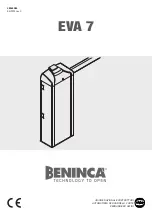
14
see section “Balancing”.
TABLE 1
BEAM
LENGTH (m)
SPRINGS TO
BE USED
INDICATIVE TENSIONING
(mm)
SPRING
364mm
SPRING
480mm
WITHOUT ACCESSORIES
5
1 spring, 480
35
5,5
1 spring, 480
90
6
1 spring, 364
1 spring, 480
31
15
6,5
2 springs, 480
5/5
7
2 springs, 480
35/35
WITH ACCESSORIES*
5
1 spring, 480
100
5,5
1 spring, 364
1 spring, 480
52
138
6
2 springs, 480
20/20
6,5
2 springs, 480
65/65
7
**
* One or more of these accessories: upper cover, flashing lights EVA.L,
SC.RES, VE.RAST, VE.AM.
** A 7 m long beam can be used only without accessories.
HOW TO FIX THE BEAM
FIG.6
Any accessories for the beam (protection edges, lights, pneu-
matic safety edges, rack, etc. ) are installed before fitting the
beam. See relevant instructions.
Fit the beam to plate P by using bracket S and both the 6
screws with the corresponding washers, and plate T.
Apply the removable plastic cover C.
PREPARATION OF A RIGHT-HAND OR
LEFT-HAND ROAD BARRIER
FIG.7-8
If it is necessary to modify the opening direction of the road
barrier from right-hand to left-hand, or viceversa, proceed
as follows:
• totally unload the springs by loosening them and unhook
them from the anchoring lever “L” (fig. 8)
• remove screws D1 and D2 and fix the extension rod A in
the opposite position, on lever V.
• remove and fix the extension lever R in the opposite po-
sition.
• fix the springs onto the anchoring lever “L” .
• Fig. 8 shows the different positions of the components
shows the differences between a right-hand road barrier
and a left-hand one.
• in the control unit, invert the wires of motor, as well
as SWC limit switch (closing limit switch) and SWC-R
limit switch (closure braking limit switch).
EMERGENCY MANUAL OPERATION
FIG.9
Should a power failure occur or in the event of faults in the
system, the beam can be released and moved by hand:
• Introduce the customized key in the release lever and turn
it clockwise.
• Turn the release lever clockwise until the beam is released
and it can be opened and closed by hand.
• To reset the automatic operation, turn the lever anti-
clockwise until the beam is released. Reset the initial
position.
BALANCING
FIG.10
For a good operation of the road barrier, the beam must be
suitably balanced by the spring.
To check the correct balancing, proceed as follows:
• Mechanically release the road barrier through the release
key.
• The road beam, correctly balanced at approx. 45° , should
remain still in any position:
- if it tends to open, reduce the spring tension
- if it tends to close, increase the spring tension
The spring tension can be adjusted by tightening (anti-
clockwise rotation) or loosening (clockwise rotation) the
spring by hand. Once the spring tension is adjusted, lock
it by moving the nut “D” in contact with cap T.
• In table 1 of the “indicative tensioning” column, mea-
sures (expressed in millimeters) are shown. To obtain a
tensioning value near to optimal, these measures must
be added to the spring length in rest position.
For example:
In the event of a road beam 5.5m long, with installed ac-
cessories, the 364mm spring should be tensioned until
a length of 416mm (364+52), while the 480mm spring
should be tensioned at a length of 618mm (480+138).
When two 480mm springs are used, the tensioning value
of the two springs must be the same.
MOVEMENTS AND OPERATING TIME
During opening as per Fig. 11:
Starting from the closing position “C”, the beam starts its
opening until it reaches the “SWO-R” point, where the ope-
ning limit switch triggers. The opening speed can be adjusted
through the control unit.
The beam moves for the remaining space (as shown in Fig.11)
at a reduced speed, for a time preset by the control unit.
Therefore, the barrier reaches point A, by completing the
opening movement.
During closure, as per Fig. 12:
The beam starts moving from the opening point “A” and stops
at “SWC-R “ point, when the braking limit switch triggers. The
closing speed can be preset through the control unit.
After activation of the braking limit switch, the braking cycle
starts, ending only when the closing limit switch “C” trig-
gers.
The control unit checks the activation of the “SWC” limit
switch and it is able to automatically offset any changes due
to different weather conditions, for example.
The braking angle shown in Fig.12 is fixed at around 25°.
Adjustments of the limit switch cams, trimmers and dip-
switches should be carried out by referring to these operating
principles.
ADJUSTMENT OF LIMIT SWITCH CAMS
FIG.13
The adjustment of the limit switch cams allow for the fol-
lowing:
Cam O
To advance or delay the starting of braking in the opening
phase (Fig.12 - “SWO-R” point).
Cam C
Summary of Contents for EVA.7
Page 2: ...2 1 375 300 260 460 1265 Min 4 70m Max 6 70m 3 D 2 EVA7 SX EVA7 DX...
Page 4: ...4 7 8 D1 R D2 A V L L...
Page 5: ...5 9 10 CL CLACK D T...
Page 6: ...6 11 13 12 SWO R A C A SWC R C SWC SWC R O C SWC...
Page 7: ...7 14 15 3 1 2 4 4 5 6 7 3x1 5mm 2x1mm F2 F1 V2 V1...
Page 40: ...AUTOMATISMI BENINC SpA Via Capitello 45 36066 Sandrigo VI Tel 0444 751030 r a Fax 0444 759728...





























